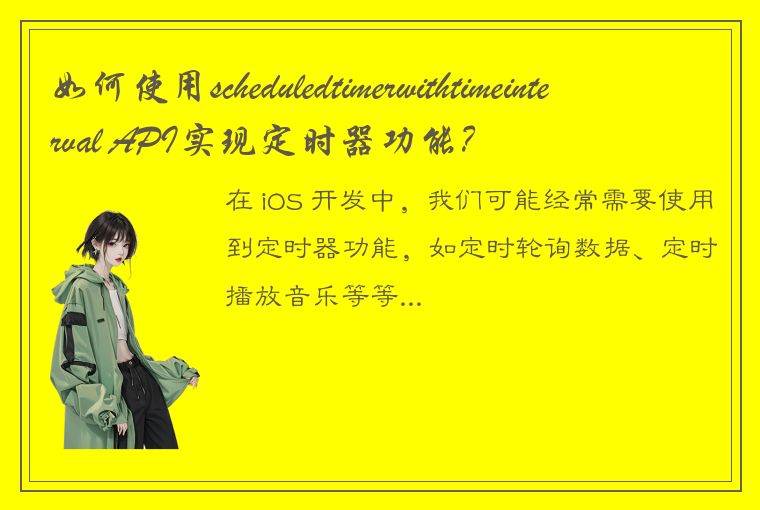在 iOS 开发中,我们可能经常需要使用到定时器功能,如定时轮询数据、定时播放音乐等等。在这里,我们就来介绍如何使用 scheduledTimerWithTimeInterval API 实现定时器功能。

scheduledTimerWithTimeInterval 是 Foundation 框架中 NSTimer 类提供的一个类方法,用于创建一个定时器对象,并指定其触发时间间隔和触发方法,以及可选的用户信息。下面我们将详细介绍如何使用 scheduledTimerWithTimeInterval 实现定时器功能。
首先,让我们来看看该 API 的定义:
```
+ (NSTimer *)scheduledTimerWithTimeInterval:(NSTimeInterval)interval target:(id)target selector:(SEL)aSelector userInfo:(nullable id)userInfo repeats:(BOOL)repeats;
```
从上述定义中,我们可以看出 scheduledTimerWithTimeInterval 方法包含五个参数,分别是:
- interval:触发时间间隔,单位为秒。
- target:触发方法所属的对象。
- aSelector:触发方法。
- userInfo:可选的用户信息,可以为 nil。
- repeats:定时器是否重复触发,即是否循环执行。
接下来我们通过一个实例来演示如何使用 scheduledTimerWithTimeInterval 实现定时器功能。我们将创建一个计时器,每秒钟更新一次标签上的时间。
1. 创建一个新的 iOS 项目
打开 Xcode,选择创建一个新的 iOS 项目。我们选择 Single View App 模板,并填写项目名称和组织名,如下图所示:

2. 创建 UI 视图
在 Main.storyboard 中,我们将创建一个标签和一个按钮,如下图所示:

标签用于显示时间,按钮用于触发定时器。
3. 添加定时器代码
在 ViewController.m 文件中添加以下代码:
```
#import "ViewController.h"
@interface ViewController ()
@property (weak, nonatomic) IBOutlet UILabel *timeLabel;
@property (strong, nonatomic) NSTimer *timer;
@property (assign, nonatomic) NSInteger count;
@end
@implementation ViewController
- (void)viewDidLoad {
[super viewDidLoad];
// Do any additional setup after loading the view.
}
- (IBAction)startButtonTapped:(id)sender {
if (self.timer == nil) {
self.timer = [NSTimer scheduledTimerWithTimeInterval:1.0 target:self selector:@selector(updateTime) userInfo:nil repeats:YES];
}
}
- (IBAction)stopButtonTapped:(id)sender {
if (self.timer != nil) {
[self.timer invalidate];
self.timer = nil;
}
}
- (void)updateTime {
self.count++;
self.timeLabel.text = [NSString stringWithFormat:@"%ld", self.count];
}
@end
```
在以上代码中,我们创建了一个 ViewController 类,并声明了三个属性:
- timeLabel:用于显示时间的标签。
- timer:定时器对象。
- count:计数器,用于更新时间。
在 startButtonTapped: 方法中,我们判断定时器对象是否为空,如果为空,则创建一个新的定时器对象,触发时间为 1 秒,target 为当前 ViewController 对象,selector 为 updateTime 方法。repeats 参数设置为 YES,表示定时器将循环执行。
在 stopButtonTapped: 方法中,我们判断定时器对象是否为空,如果不为空,则停止定时器并释放定时器对象。
在 updateTime 方法中,我们更新计数器,使时间每秒钟更新一次,并将更新后的时间显示在标签上。
4. 运行项目
现在我们可以运行该项目,并点击开始按钮和停止按钮,进行定时器的启动和停止。标签上将显示当前的时间,如下图所示:

5. 总结
本文介绍了如何使用 scheduledTimerWithTimeInterval API 实现定时器功能,并演示了如何创建一个简单的计时器。当然,该 API 还有很多应用场景,如定时发送网络请求、定时删除缓存文件、定时跑动画等等。希望本文对大家有所帮助。




 QQ客服专员
QQ客服专员 电话客服专员
电话客服专员